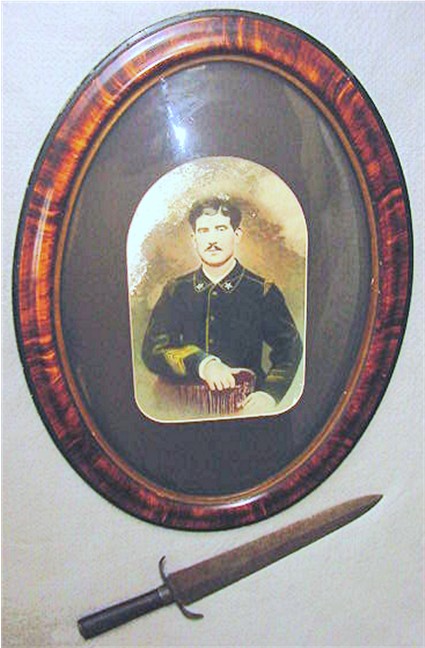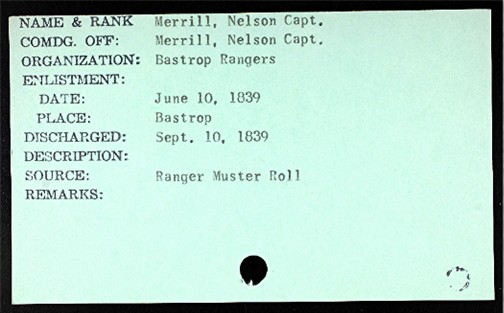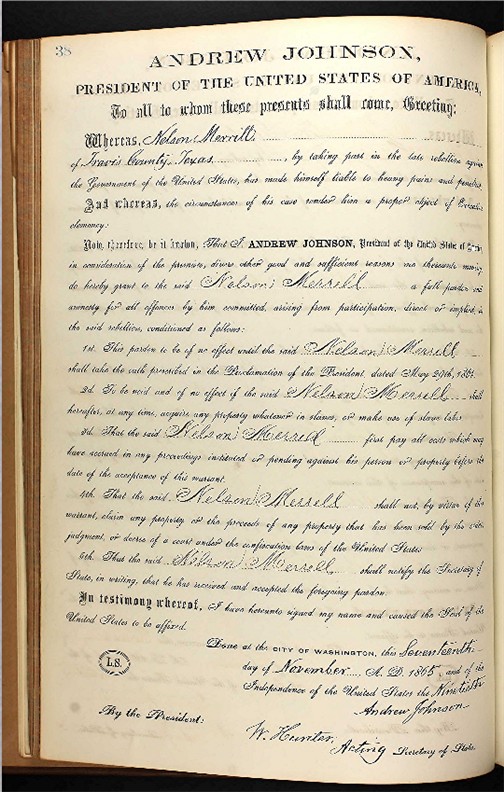|
EARLY TEXAS REPUBLIC ERA RANGER CAPTAIN GROUPING – LARGE
OVAL PORTRAIT UNDER DOMED GLASS AND LARGE FRONTIER MADE
SIDE KNIFE – A VERY SPECIAL OFFERING OF A RARE GROUPING:
Any image, artifact or document related to the early
years of the Texas Republic have always been some of the
most sought after genres of collectibles. The
comparatively small population, the hard Texas
environment, and the many years of constant violent
clashes along the frontier which destroyed family
holdings, resulted in a very limited number of surviving
examples.
As with many of the early Texas personalities, while
Captain Nelson Merrill was certainly instrumental in
forming the Republic and eventually the State, which
would become Texas, very little of his personal property
in the way of tangible artifacts survived his passing
into history. This special pairing of a dramatic oval
portrait of the Captain, measuring 23” high and 11”
wide, and an imposing 15 ˝” long frontier-made side
knife attributed to the Captain recently surfaced in a
Central Texas estate, and may well be the only surviving
mementoes of his life.

Nelson Merrill was born in Connecticut on October 8,
1810, the son of Erastus Merrill and by 1818, the family
had migrated west to Concord, Ohio. By 1837, Nelson had
arrived in “Tejas” where he purchased land and settled
on Brushy Creek in what is now the City of Round Rock,
Williamson County, Texas. Merrill and his first wife,
Rachael McKennan (m. 1840) built their first log home
near Kenney’s Fort, the first settlement permanent
settlement in Williamson County.
In 1839, with Austin having just been selected as the
capital of the Republic of Texas, Merrill raised a
company of "rangers" from Bastrop to protect the infant
city from hostile Indian depredations. He was elected
as the captain of the company and like many of the early
Ranger Captains, he retained the title throughout the
rest of his lifetime. Today, Nelson Merrill is
recognized in the state records as an official Texas
Ranger and his gravesite features a marker honoring that
service.

TEXAS RANGER
CARD FILE,
TEXAS ADJUTANT
GENERAL RECORDS
In the complicated years following the Texas Revolution
and the ensuring independence from Mexico, Merrill
joined the forces supporting the Republic of the Rio
Grande, an effort in northern Mexico to follow Texas and
break away from the central government in Mexico City,
and he was one of the adventurers who survived the
famous Jordan retreat from Saltillo in 1840.
In 1846, Capt. Merrill moved to the headspring of Wells
Branch which flows into Walnut Creek, in Travis County,
some sixteen miles north of the center of Austin. A
post-office was established around 1851, and he was
appointed postmaster, and the growing settlement was not
surprisingly named Merrilltown. Probably located in the
same building, Merrill operated a store that not only
provisioned his neighbors, but also served as a
stagecoach stop. He was involved with the construction
of Congress Avenue, the first “main drag” in Austin, and
he served as a Travis County Commissioner from 1852 to
1859.
By 1859, Merrilltown was one of the principal towns in
Travis County, and included churches, a school and a
hotel. While natives still refer to community as
Merrilltown, the area has been long since absorbed into
the city limits of Austin. There is also a road in the
Wells Branch area where Merrilltown is located -
"Merrilltown Road".
While I have not been able to find the details, in spite
of his advanced years Merrill apparently served in the
Confederate Army during the Civil War as he was issued
the standard pardon (shown below) by President Andrew
Johnson in November of 1865. Where and when he
served is not known at this time, but its obvious there
would have been no need for the pardon if he did not
serve the Confederacy.

In the early 1870s, Merrill returned to Williamson
County to live on the Brushy Creek land he purchased
when he arrived in Texas some thirty years before.
Antria Smith, a French born stonemason, was contracted
to build a distinctive two-story rock house on the
plantation-style property for the cost of $1600 on what
is now called Palm Valley Blvd. (Hwy 79). A cupola
topped the house, which was accessed by a spiral iron
staircase imported from London. From there, via
telescope Merrill would monitor his laborers in the
surrounding fields. The home, known as the "Merrell
Plantation", (note the misspelling of his last name on
this title) is listed in the National Register of
Historic Places and now serves as an upscale wedding and
party venue.
Captain Nelson Merrill died at home on January 11, 1879
and is buried in Merrilltown Cemetery, Austin, Travis
Co.
This portrait of Captain Merrill was produced using the
Solar Enlargement, a method of artistic production
popular from about 1860 to 1910. In 1857, David Acheson
Woodward of Baltimore, Maryland, patented the first
widely successful photographic enlarging camera. He
continued to make improvements to his solar camera in a
series of patent renewals in the 1860s and 1870s. These
cameras were usually mounted on a studio roof and were
designed to turn to follow the sun. They were large,
heavy devices that used condensers to focus the light
from the sun and a copying lens that projected a small
negative onto a large sheet of sensitized photographic
paper or canvas.
Due to the expense of commissioning portraits from life,
solar portraits involved a more efficient and cost
effective way of producing images, wherein a photograph
was projected onto a canvas using light, and the image
was then traced and painted over in the medium of
choice. The resulting image would have the realism of a
photograph, but the handcrafted quality of an oil
painting. This method also allowed for several copies
of an original photograph to be made to share with
others, something not previously possible with the
one-of photography techniques of the period.
The image of Merrill measures 11” high and 7” wide, is
mounted in an oval frame measuring 23” high and 11”
wide, and is protected under an original curved face
glass. The image is clear and shows no damage. An
imposing portrait, the captain is captured in his middle
age and wearing a dark blue uniform coat trimmed with a
single star on each collar corner, and with gold braid
on the edges of the collar, across the shoulders, along
the front opening, and similar gold braid on each
sleeve, probably as a badge of rank. The reverse of the
frame is covered in the standard brown paper glued
around the edge. At the top of this paper backing is
hand written in pencil, “CAPT MERRILL”.
Accompanying the portrait is a large, frontier made side
knife, typical of the knives carried by men during the
percussion arms era when they depended heavily on their
edged weapons. The knife measures 15 ˝” in overall
length, with an impressive blade measuring 11” long and
a full 2” across the base. The double edged blade is
well made, retains its original form, and the edges have
several nicks significant to indicate the knife was well
used as intended. The knife is fitted with a simple,
utilitarian wood grip fitted with an iron band just
above the guard and a flat iron cap at the top over
which the tang is peened to secure the grip. The cross
guard is oversized as you would expect on a fighting
knife, made of iron and measuring 4” long, turned down
on the ends so to be able to parry the incoming blade of
an opponent.
There are no maker marks or names on the knife, however
the knife and the portrait have been together for some
time. I was able to track the sale of this set back
through the original sale from a dealer and two
subsequent auction sales, covering a considerable period
of time. At some point, while the knife and portrait
were attributed to Capt. Merrill, he was incorrectly
identified as having been a member of the 7TH
Texas Mounted Rifles during the Civil War. Since the
captain would have been 50 years old at the start of the
war, his service in the war was unlikely and no record
of his service during the war can be found.
Nonetheless, this same identification listed Merrill as
captain, and as having been from Austin – no doubt this
same ranger captain described here. It is far more
likely that given his prior ranger service, he was one
of the many rangers who remained in Texas during the war
to defend the state’s vast frontier from depredations by
the Indians.
A binder of biographical
information and photographs of Captain Merrill’s home
and grave site accompany the sale of this grouping.
This is a very special grouping, reflecting the
hardiness and sense of adventure of the early settlers
of Texas, and has the added value of preserving the
image and weapon of one of the early, and well known,
Texas Ranger Captains. Simply put, you will not find
another such as this. (0348) $2500
|

